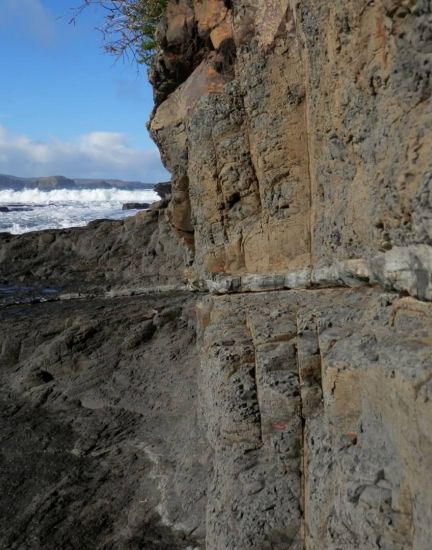
History
The Catlins has some of New Zealand’s oldest sedimentary rocks. The geological processes that laid the foundations of The Catlins began about 200 million years ago. At that time, New Zealand was part of the Gondwanaland super-continent.
Today these Triassic and Jurassic rocky foundations, which contain many dinosaur-age fossils of marine and plant life, provide much interest. The rocks were initially laid down as horizontal layers of sand and mud in the sea or on land, consolidated and then were subjected to geological uplift, folding and faulting creating an ancient mountain range.
Over the last 80 million years or so the mountains were worn down as uplift stopped and the area became geologically stable. In the cliffs, the rock faces, and in the shape of the hills, the evidence of the past upheavals can be seen.
Fault lines are visible in the cliffs at Nugget Point and at the Cathedral Caves where sea erosion has carved out caves and chasms along the faults. Fossils in The Catlins famously include ferns and tree species that grew on Gondwanaland before ancestral New Zealand broke away about 80 million years ago. These ancient plants still have their descendants in the tree ferns and podocarp trees of the present native forests.
Fossils
Plant fossils are found throughout The Catlins but are more frequent in the south and west. This reflects the location of land in Gondwanaland times.
Curio Bay is the location most well-known for seeing the trunks of ancient trees as well as thin seams of coal and associated leaf impressions.
Plant fossils are also common in the places where younger rocks are exposed. This is because the land with trees on it was slowly extending out into the sea over time. The youngest rocks (mid Jurassic) of The Catlins are to be found at Otara and in the Waikawa, Chaslands, Tahakopa and Catlins River valleys.
Fossils of animals that lived in the sea are very common. They are usually in the form of impressions of Bivalve and Brachiopod shellfish; and the remains of ancient Cephalopods such as Belemnites and Ammonites are also reasonably common as are the traces of animals such as worms.
The best places to look for marine fossils are where rocks are freshly exposed along the coast from Nugget Point to Papatowai.
The Landscape
The Catlins area has a diverse landscape made up of many ranges and valleys, streams and rivers. It is a predominantly green landscape as a result of plentiful rain throughout the year.
Nutrients
Winds from the ocean bring in copious amounts of nutrients such as sulphates, magnesium, calcium, potassium; and along with the salty air this makes for excellent pasture growth and healthy growing conditions for grazing animals which are now the mainstay of the local economy.
The modest clover plant which fixes nitrogen in the soil as well as providing nutritious feed for sheep, cattle and deer, is the key to The Catlins agricultural production.
Shelter Belts
Farm homes are generally surrounded by thick shelter belts designed to deflect wind up and over the homestead area.
Flaxes, Olearia and Cupressus Macrocarpa are commonly used for shelter belts.
Macrocarpa or Monterey cypress is one of the few large trees which can resist the salt laden winds from the sea and these were often planted to shelter the first homesteads. Such trees, for instance at Slope Point, (the southernmost point of the South Island), provide dramatic photographic opportunities.
The Seascape
The Catlins coastline is unlike any other on the east coast of the South Island. It is rugged, forested in places and very scenic.
It has sea cliffs which rise to 200 metres, reefs, rock stacks, blowholes, arches, caves, reefs, sandy beaches, estuaries and coves. Most dramatically, it also has the Curio Bay Petrified Forest which allows a glimpse of a young forest of Jurassic-age conifer trees that was vibrant with life 150 million years ago.
Sea coast
The sea coast has many native plants which have adapted to the salty winds. They range from flaxes to blue-grey tussocks and flowering gems such as mountain daisies, gentians and sand convolvulus. The increasingly rare Pingao, a beautiful green-orange sedge, has been almost completely ousted by the introduced marram grass.
Seaweed and shell fish
Seaweeds, shells, and colourful gravels and sands add interest to the natural history of the coastline.
The gloriously iridescent paua shell is often washed up on the beach, as are Captain Cook’s turbans, brachiopods, fan shells, cats’ eyes, mussels, and wheel shells, to name a few.
Giant bull kelp impresses visitors as it moves in the surge of the ocean, like the tresses of a mysterious underwater being. There are bright green, white, pink and brown seaweeds on the reefs and myriads of small crabs and chitons under loose rocks.
Look at the brochure for more information on rocks, landforms and where you can find them in The Catlins.